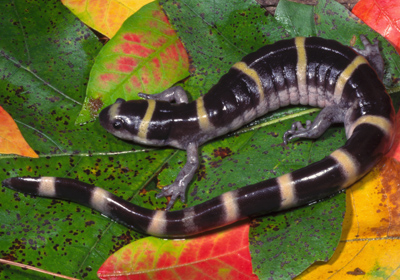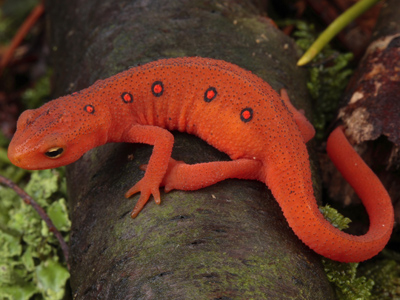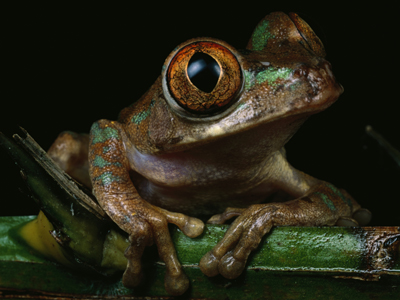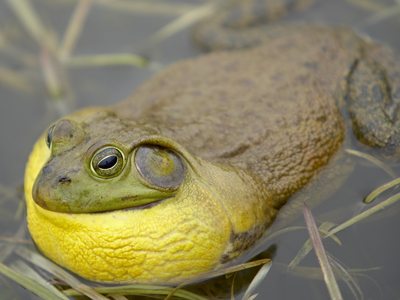Amphibians
Amphibians are a class of cold-blooded vertebrates, including frogs, toads, salamanders, newts, and caecilians. They spend their lives partly in water and partly on land. They must inhabit a moist environment to survive. Amphibians’ bodies are much more sensitive to the environment due to their porous eggs and semipermeable skin, making them extremely susceptible to environmental threats, such as disease, pollution, habitat destruction, temperature changes and toxic chemicals. Therefore, amphibians are very good indicators of significant environmental changes, and critical to maintaining healthy ecosystems. Amphibians are an essential part of the food chain because they are both top insectivores and prey for other animals. Numerous medicines use ingredients extracted from amphibians, and new ingredients keep being discovered.
Amphibians have been on the decline for some time. Pollution, global warming and habitat destruction from human development have been devastating — water and land have become dangerous places to inhabit, filled with toxins from industries and pesticides; large amounts of lead from car exhaust are deposited in ponds and lakes through stormwater. Rising temperatures disrupt breeding and hibernation patterns, making amphibians more vulnerable to weather changes and more susceptible to disease.
Every year, hundreds of millions of frogs are killed; their legs consumed worldwide. As a result, frog populations have collapsed in Europe, North America and Asia. In some places, frogs face the risk of becoming regionally extinct, for instance, water frogs in Turkey and some species in South and Central America. Loss of these insect eaters has meant significantly increased use of insecticides, at a cost often higher than the revenue from frog leg exports. The environmental costs add insult to injury.
Additional losses are suffered because some amphibians are kept as pets, often in stressful conditions. It is not uncommon that some are flushed down the toilet when kids grow tired of them.
In addition to human influence, a newly identified parasitic fungus (chytrid fungus) is speeding up the demise of amphibians worldwide. The fungus coats the frog’s skin and makes its pores non-functional; clogged pores make it difficult to breathe and cause frogs to die from dehydration. Multi-million-dollar projects have been launched worldwide to capture and treat infected amphibians before releasing them back into the wild. At this moment, only experimental treatments have been applied, with little success in improving the survival rates or controlling the spread of fungus on a large-scale; no effective treatment has been found yet.

Why should we care?
- Amphibians are important indicators of significant environmental changes.
- Amphibians play an important role in the food chain as both predator and prey; they are a top insectivore which benefits agriculture and minimizes spread of disease.
- Pain killers rely on frogs for at least one active ingredient.
- AIDS researchers have found a chemical in frogs that seems to have an anti-HIV effect.
- Frog skin has substances that protect them from some microbes and viruses, offering promising medical cures for a variety of human diseases.



Fast facts
- According to the International Union for Conservation of Nature (IUCN), as of 2008, 42% of amphibian species showed evidence of decline, and 32% were globally threatened (Critically Endangered, Endangered or Vulnerable categories) or extinct; 38 species have gone extinct and an additional 120 species are likely extinct.
- By November 2016, the IUCN had evaluated 6,492 of the 7,500 amphibian species currently recognized by amphibiaweb.org, with decline percentages remaining unchanged.
- Frogs have lost an estimated 170 species in the last decade, with another 1,900 in a threatened state.
- Two-thirds of some amphibian species in Central and South America are gone.
- The annual global trade in frogs for human consumption has increased over the past 20 years with at least 200 million and maybe over 1 billion frogs consumed every year.
- Indonesia supplied nearly half of frog legs for international trade, while France, Belgium and the US imported over 75% of all frog legs traded.
- The Australian National University (ANU) has found that chytrid fungus has caused dramatic population declines in more than 500 amphibian species, including 90 extinctions, over the past 50 years.
- it is also estimated that the parasitic fungus can kill 80% of native amphibians within months once it has taken hold. Projectshave been launched worldwide to implement amphibian protection programs in zoos, botanical gardens and aquariums.

